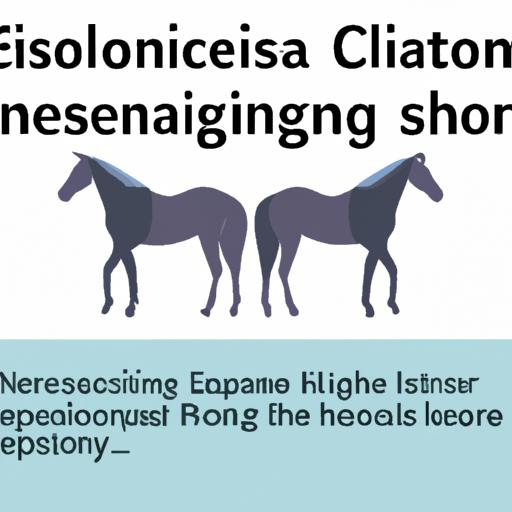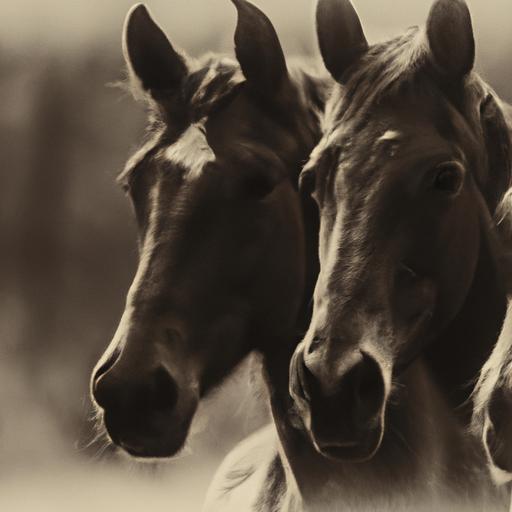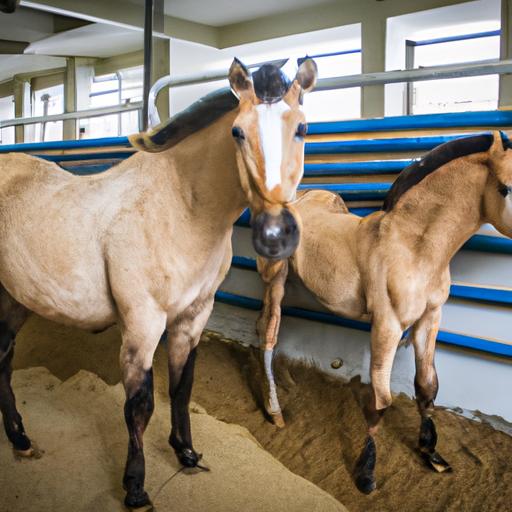Unlock the secrets behind the fascinating process of cloning horses, exploring its importance, applications, and the future possibilities it holds.
Cloning has revolutionized various scientific fields, and the realm of horse breeding is no exception. Have you ever wondered how cloning horses works? In this article, we will delve into the captivating process of cloning horses, uncovering its significance and applications in the equine world. Join me as we embark on a journey through the history, techniques, and future possibilities of horse cloning.
Introduction

A. Overview of Horse Cloning
Horse cloning involves the creation of genetically identical copies of horses through a complex scientific procedure. By utilizing advanced reproductive technologies, scientists are able to duplicate the genetic material of a donor horse to create a new individual with the same traits and characteristics. This breakthrough has tremendous implications for the equine industry, offering a range of possibilities and benefits for horse breeders, athletes, and enthusiasts alike.
B. Importance and Applications of Cloning Horses
The process of cloning horses holds immense importance in the world of horse breeding. By replicating exceptional horses with desirable traits, breeders can preserve and propagate superior genetic lines, ensuring the perpetuation of exceptional bloodlines for future generations. Additionally, cloning allows for the conservation of rare and endangered horse breeds, safeguarding their genetic diversity and preventing their extinction.
Furthermore, cloning has significant applications in various equine disciplines. Cloned horses have the potential to excel in racing, show jumping, dressage, and other equestrian sports. Their unique genetic makeup provides an opportunity to replicate winning champions, enhancing athletic performance, and pushing the boundaries of equine achievements.
C. Brief History of Horse Cloning
The fascinating journey of horse cloning dates back to the early 2000s when the first successful clone, a mare named “Prometea,” was born. Since then, numerous advancements have been made in cloning technology, refining the process and improving success rates. While horse cloning is still a relatively new field, it has garnered significant attention and continues to evolve, captivating the interest of scientists, breeders, and horse enthusiasts worldwide.
Stay tuned as we dive deeper into the intricate process of cloning horses, exploring the steps involved, the challenges faced, and the remarkable success stories that have emerged. Join me in unraveling the mysteries of this groundbreaking technology and discovering the potential it holds for the future of the equine world.
Next up, we will discuss the detailed steps involved in cloning horses, shedding light on the intricacies of this fascinating process.
Understanding the Cloning Process

Cloning, in general, is a fascinating scientific process that involves the replication of an existing organism. When it comes to horse cloning, the procedure is intricate and relies on several crucial steps. Let’s explore the detailed process involved in cloning horses, from the collection of donor cells to the birth and post-cloning care.
A. Explanation of Cloning in General
Cloning is a technique that allows scientists to create genetically identical copies of an organism. It involves the transfer of genetic material from a donor cell into an egg cell that has had its nucleus removed, resulting in the production of an embryo with the same genetic makeup as the donor. This process is known as somatic cell nuclear transfer (SCNT) and is the core technique used in horse cloning.
B. Detailed Steps Involved in Cloning Horses
1. Collection and Preparation of Donor Cells
The first step in the horse cloning process is the collection of donor cells. These cells, usually obtained from a high-performing horse, can be sourced from various tissues, including skin or muscle biopsy samples. Once collected, the donor cells undergo a series of laboratory procedures to prepare them for the cloning process.
2. Nuclear Transfer Technique
The nuclear transfer technique is the key step in horse cloning. It involves removing the nucleus of an unfertilized egg cell and replacing it with the nucleus from a donor cell. This reconstructed embryo is then stimulated to initiate cell division and development.
3. Embryo Transfer and Pregnancy
After the nuclear transfer, the reconstructed embryo is transferred into the uterus of a surrogate mare. The recipient mare carries the cloned embryo throughout the pregnancy, providing a nurturing environment for its development. Regular monitoring and veterinary care are essential to ensure the health and well-being of both the surrogate mare and the developing clone.
4. Birth and Post-Cloning Care
Following a successful pregnancy, the cloned horse is born. Vigilant post-cloning care is crucial during the early stages of the clone’s life, ensuring proper nutrition, socialization, and veterinary support. Close monitoring and appropriate management practices are essential to maximize the clone’s health and well-being.
Understanding the intricate process of cloning horses gives us a glimpse into the remarkable advancements in reproductive technologies. In the next section, we will explore the challenges and limitations associated with horse cloning, shedding light on the potential risks and ethical considerations involved.
Challenges and Limitations of Horse Cloning

As with any ground-breaking scientific advancement, the process of cloning horses comes with its own set of challenges and limitations. While the potential benefits are enticing, it is crucial to understand and address the concerns that arise in the realm of horse cloning.
A. Health Risks and Genetic Abnormalities
One of the primary challenges associated with horse cloning is the increased risk of health issues and genetic abnormalities in cloned horses. Despite scientific advancements, cloned horses have a higher likelihood of developing certain conditions such as musculoskeletal problems, respiratory disorders, and immune system deficiencies. These health risks stem from epigenetic factors, which are modifications in gene expression that can occur during the cloning process. As a result, it is essential to closely monitor the health and well-being of cloned horses, providing them with specialized care to mitigate potential complications.
B. Expensive and Complex Procedure
Another notable limitation of horse cloning lies in its cost and complexity. The process of cloning horses involves intricate and highly specialized techniques, requiring skilled professionals, advanced laboratory equipment, and substantial financial resources. From the collection and preparation of donor cells to the embryo transfer and pregnancy stages, each step demands meticulous attention and expertise. The expenses associated with cloning horses can be prohibitive for many breeders and individuals, limiting its widespread adoption and accessibility.
C. Ethical Concerns Surrounding Horse Cloning
Ethical considerations also play a significant role in the realm of horse cloning. While cloning offers the potential to replicate exceptional individuals, it raises ethical questions regarding the manipulation of nature and the welfare of cloned animals. Some argue that cloning exploits animals for human desires and interferes with the natural process of reproduction. Additionally, concerns arise regarding the potential for over-reliance on cloning, which could limit genetic diversity and hinder overall breed health. These ethical concerns necessitate ongoing dialogue and careful consideration to ensure responsible and ethical use of horse cloning technology.
Despite these challenges and limitations, the field of horse cloning continues to progress, driven by the potential benefits it holds. By addressing these concerns, researchers and breeders can work towards refining the process, enhancing the well-being of cloned horses, and ensuring its ethical implementation.
Stay tuned as we explore the remarkable success stories of cloned horses, shedding light on their achievements and contributions in various disciplines.
Success Stories of Cloned Horses
Cloning technology in the equine world has given rise to remarkable success stories, where cloned horses have showcased their exceptional abilities and made significant contributions across various disciplines. Let’s delve into some notable examples, explore their achievements, and understand the impact they have had on the horse racing industry.
A. Notable Examples of Cloned Horses
One of the most renowned cloned horses is “Gem Twist 2,” a clone of the legendary show jumper “Gem Twist.” Gem Twist 2 has inherited the exceptional jumping abilities and agility of its predecessor, captivating audiences with its stunning performances. This remarkable clone serves as a testament to the potential of cloning technology in preserving and perpetuating exceptional bloodlines.
Another prominent example is “Tio Mateo,” a clone of the renowned polo pony, “Cuartetera.” Tio Mateo has taken the polo world by storm, showcasing the same speed, agility, and intelligence that made Cuartetera an iconic figure in the sport. This clone has not only impressed spectators but has also proven invaluable in perpetuating the genes of an outstanding polo pony.
B. Achievements and Contributions of Cloned Horses in Various Disciplines
Cloned horses have made significant contributions across various equestrian disciplines. In show jumping, clones such as “E.T. Cryozootech” and “Cristallo II” have displayed exceptional talent and achieved notable successes in international competitions. These clones have demonstrated that cloning technology can be a valuable tool in preserving and perpetuating the genetic traits that contribute to exceptional athletic performance.
In the realm of horse racing, clones have also left their mark. “Pieraz” and “Pure Clone” are prime examples of cloned racehorses who have showcased their speed, endurance, and racing prowess on the track. These clones have not only proven themselves as formidable competitors but have also sparked discussions and debates about the future of horse racing and the potential impact of cloning on the industry.
C. Impact on the Horse Racing Industry
The success of cloned horses in the racing industry has created a ripple effect, stirring discussions and debates among industry professionals and enthusiasts. While some view cloning as a means to replicate winning champions and enhance the competitiveness of the sport, others express concerns about the potential implications on the integrity of horse racing.
Cloning has the potential to challenge traditional breeding methods and reshape the landscape of horse racing. As the technology continues to evolve and success stories emerge, it is crucial to carefully consider the ethical, regulatory, and competitive implications of incorporating cloned horses into the racing industry.
Stay tuned as we explore the future possibilities and ongoing research in horse cloning, shedding light on the advancements that lie ahead and the potential impact they may have on the equine world.
Future Possibilities and Research in Horse Cloning
As the field of horse cloning continues to progress, exciting advancements in cloning technology are on the horizon. Let’s explore the potential applications, benefits, and ongoing research projects that are shaping the future of horse cloning.
A. Advancements in Cloning Technology
Scientists are constantly pushing the boundaries of cloning technology to enhance success rates and refine the process. With each new breakthrough, the efficiency and reliability of horse cloning improve. Advancements in genetic engineering techniques, such as somatic cell nuclear transfer (SCNT) and induced pluripotent stem cells (iPSCs), hold promise for further advancements in horse cloning. These cutting-edge technologies enable scientists to manipulate and reprogram cells, potentially revolutionizing the cloning process and expanding its possibilities.
B. Potential Applications and Benefits of Horse Cloning
The potential applications of horse cloning are vast and far-reaching. Cloning opens doors to a range of possibilities in various equine disciplines. By cloning exceptional horses, breeders can not only replicate their favorable traits but also preserve their genetic legacy. This ensures the availability of superior genetic material for future breeding programs, contributing to the improvement of horse breeds and the overall quality of equine athletes.
Furthermore, horse cloning offers a lifeline for endangered and rare horse breeds. By preserving their genetic material through cloning, these breeds can be protected from extinction and potentially reintroduced into their natural habitats. Cloning also provides an avenue for studying and understanding genetic diseases, as scientists can create genetically identical horses to conduct research and develop potential treatments.
C. Current Research and Ongoing Projects Related to Horse Cloning
The field of horse cloning is an active area of research, with ongoing projects aimed at expanding our knowledge and capabilities. Researchers are exploring ways to enhance the efficiency and viability of cloned embryos, improve the health and well-being of cloned horses, and refine the cloning techniques. Additionally, studies are underway to investigate the long-term effects of cloning on the overall health and performance of horses.
Collaborations between scientists, breeders, and industry professionals are driving the progress in horse cloning. Their collective efforts aim to overcome the remaining challenges and unlock the full potential of this groundbreaking technology.
In conclusion, the future of horse cloning holds great promise. Advancements in cloning technology, coupled with the potential applications and ongoing research projects, are shaping a landscape where cloning can revolutionize the equine world. As we eagerly await further breakthroughs, let us appreciate the immense possibilities that lie ahead. Stay tuned for more updates on the fascinating world of horse cloning.
Next, we will explore the concluding thoughts on the process of cloning horses and the importance of ethical considerations.


